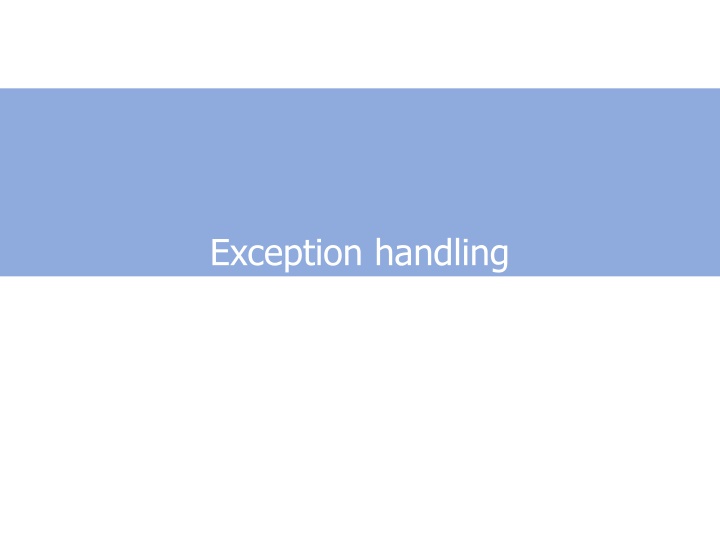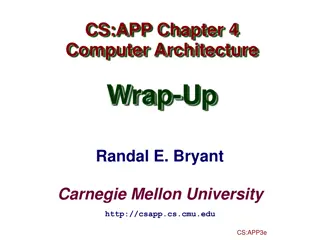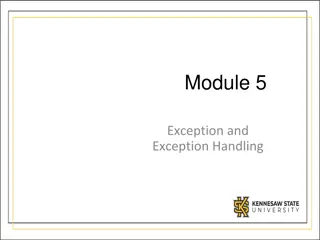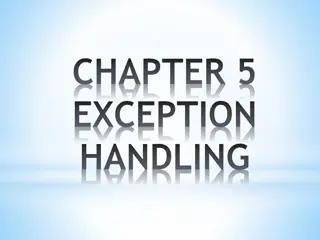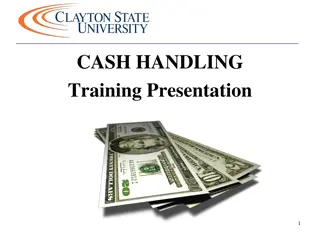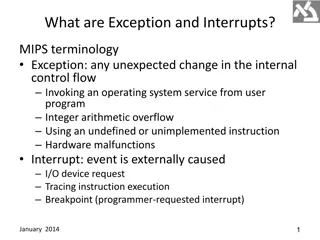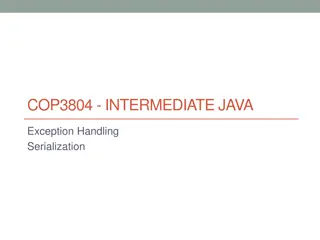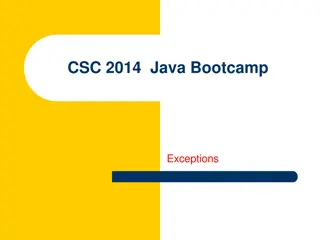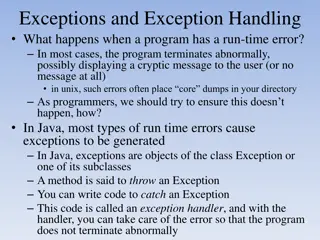Exception Handling: Understand Jumps and Destinations
Exceptions in programming act as "jumps" from a throw statement to a try-catch block, determined at runtime. Upon jumping, local variables are properly destructed, and a value is passed to determine the destination. Learn how catch-block matching works and the importance of properly handling exceptions.
Download Presentation

Please find below an Image/Link to download the presentation.
The content on the website is provided AS IS for your information and personal use only. It may not be sold, licensed, or shared on other websites without obtaining consent from the author.If you encounter any issues during the download, it is possible that the publisher has removed the file from their server.
You are allowed to download the files provided on this website for personal or commercial use, subject to the condition that they are used lawfully. All files are the property of their respective owners.
The content on the website is provided AS IS for your information and personal use only. It may not be sold, licensed, or shared on other websites without obtaining consent from the author.
E N D
Presentation Transcript
Exception handling Exceptions are "jumps" Start: throw statement Destination: try-catch block Determined at run time The jump may exit a procedure Local variables will be properly destructed by destructors Besides jumping, a value is passed The type of the value determines the destination Typically, special-purpose classes Catch-block matching can understand inheritance class AnyException { /*...*/ }; class WrongException : public AnyException { /*...*/ }; class BadException : public AnyException { /*...*/ }; void f() { if ( something == wrong ) throw WrongException( something); std::string locvar1; if ( anything != good ) throw BadException( anything); } void g() { try { std::ofstream locvar2; f(); } catch ( const AnyException & e1 ) { /*...*/ } }
Exception handling Exceptions are "jumps" Start: throw statement Destination: try-catch block Determined at run time The jump may exit a procedure Local variables will be properly destructed by destructors Besides jumping, a value is passed The type of the value determines the destination Typically, special-purpose classes Catch-block matching can understand inheritance The value may be ignored class AnyException { /*...*/ }; class WrongException : public AnyException { /*...*/ }; class BadException : public AnyException { /*...*/ }; void f() { if ( something == wrong ) throw WrongException( something); std::string locvar1; if ( anything != good ) throw BadException( anything); } void g() { try { std::ofstream locvar2; f(); } catch ( const AnyException &) { /*...*/ } }
Exception handling Exceptions are "jumps" Start: throw statement Destination: try-catch block Determined at run time The jump may exit a procedure Local variables will be properly destructed by destructors Besides jumping, a value is passed The type of the value determines the destination Typically, special-purpose classes Catch-block matching can understand inheritance The value may be ignored There is an universal catch block class AnyException { /*...*/ }; class WrongException : public AnyException { /*...*/ }; class BadException : public AnyException { /*...*/ }; void f() { if ( something == wrong ) throw WrongException( something); std::string locvar1; if ( anything != good ) throw BadException( anything); } void g() { try { std::ofstream locvar2; f(); } catch (...) { /*...*/ } }
Exception handling Exception handling consists of Evaluating the expression in the throw statement The value is stored "somewhere" Stack-unwinding Blocks and functions are being exited Local and temporary variables are destructed by calling destructors Inside a destructor, another instance of exception handling may be executed The destructors must not let their internal exceptions escape Stack-unwinding stops in the try-block whose catch-block matches the throw expression type catch-block execution The throw value is still stored may be accessed via the catch-block argument (typically, by reference) also accessible through std::current_exception "throw;" statement, if present, continues stack-unwinding Exception handling ends when the accepting catch-block is exited normally Also using return, break, continue, goto Or by throwing another exception from the catch-block
Exception handling Materialized exceptions std::exception_ptr is a smart- pointer to an exception object Uses reference-counting to deallocate std::current_exception() Returns (a pointer to a copy of) the exception being currently handled The exception handling may then be ended by exiting the catch- block std::rethrow_exception( p) (Re-)executes the stored exception like a throw statement This mechanism allows: Propagating the exception to a different thread Signalling exceptions in the promise/future mechanism std::exception_ptr p; void g() { try { f(); } catch (...) { p = std::current_exception(); } } void h() { std::rethrow_exception( p); }
Exception handling Throwing and handling exceptions is slower than normal execution Compilers favor normal execution at the expense of exception-handling complexity Use exceptions only for rare events Out-of-memory, network errors, end-of-file, ... Mark functions which cannot throw by noexcept it may make code calling them easier (for you and for the compiler) void f() noexcept { /*...*/ } You shall always explicitly mark move-constructors and move-assignments as noexcept If you are able to avoid exceptions there It will significantly improve the behavior of containers containing your type Compiler-generated functions will be noexcept if every element has its noexcept function Destructors are noexcept by default If your destructors may throw, you shall mark them noexcept(false) noexcept may be conditional on a compile-time constant Used in conjunction with type-examining traits in the standard library template< typename T> void g(T & y) noexcept( std::is_nothrow_copy_constructible_v< T>) { T x = y; }
Exception handling Standard exceptions <stdexcept> All standard exceptions are derived from class std::exception the member function what() returns the error message std::bad_alloc: not-enough memory std::bad_cast: dynamic_cast on references Derived from std::logic_error usually a mistake of the programmer domain_error, invalid_argument, length_error, out_of_range e.g., thrown by vector::at Derived from std::runtime_error usually a problem in the data or environment range_error, overflow_error, underflow_error It is a good practice to derive your exception classes from std::exception It allows anyone to display the error message by try { /*...*/ } catch (const std::exception & e) { std::cout << e.what(); } Hard errors (invalid memory access, division by zero, ...) are NOT signalized as exceptions These errors might occur almost anywhere The need to correctly recover via exception handling would prohibit many code optimizations Some compilers may be able to do it if asked
Programming with exceptions basic rules Pravidla vynucen jazykem Destruktor nesm skon it vyvol n m v jimky V jimka m e b t vyvol na uvnit , ale mus b t zachycena nejpozd ji uvnit destruktoru Zd vodn n : V r mci o et en v jimek (ve f zi stack-unwinding) se volaj destruktory lok ln ch prom nn ch V jimku zde vyvolanou nelze z technick ch i logick ch d vod o et it (ztratila by se p vodn v jimka) Nastane-li takov v jimka, vol se funkce terminate() a program kon
Programming with exceptions basic rules Pravidla vynucen jazykem Destruktor nesm skon it vyvol n m v jimky V jimka m e b t vyvol na uvnit , ale mus b t zachycena nejpozd ji uvnit destruktoru Toto pravidlo jazyka sice plat pouze pro destruktory lok ln ch prom nn ch A z jin ch d vod t pro glob ln prom nn Je v ak vhodn je dodr ovat v dy Bezpe nostn zd vodn n : Destruktory lok ln ch prom nn ch asto volaj jin destruktory Logick zd vodn n : Nesmrteln objekty nechceme
Programming with exceptions basic rules Pravidla vynucen jazykem Destruktor nesm skon it vyvol n m v jimky Konstruktor glob ln ho objektu nesm skon it vyvol n m v jimky Zd vodn n : Nen m sto, kde ji zachytit Stane-li se to, vol se terminate() a program kon Jin konstruktory ale v jimky volat mohou (a b v to vhodn )
Programming with exceptions basic rules Pravidla vynucen jazykem Destruktor nesm skon it vyvol n m v jimky Konstruktor glob ln ho objektu nesm skon it vyvol n m v jimky Copy-constructor typu v hlavi ce catch-bloku nesm skon it vyvol n m v jimky Zd vodn n : Catch blok by nebylo mo n vyvolat Stane-li se to, vol se terminate() a program kon Jin copy-constructory ale v jimky volat mohou (a b v to vhodn )
Programming with exceptions basic rules Pravidla vynucen jazykem Destruktor nesm skon it vyvol n m v jimky Konstruktor glob ln ho objektu nesm skon it vyvol n m v jimky Copy-constructor typu v hlavi ce catch-bloku nesm skon it vyvol n m v jimky
Programming with exceptions basic rules Pozn mka: V jimky p i zpracov n v jimky V jimka p i v po tu v razu v throw p kaze Tento throw p kaz nebude vyvol n V jimka v destruktoru p i stack-unwinding Povolena, pokud neopust destruktor Po zachycen a norm ln m ukon en destruktoru se pokra uje v p vodn v jimce V jimka uvnit catch-bloku Pokud je zachycena uvnit , o et en p vodn v jimky m e d le pokra ovat (p ikazem throw bez v razu) Pokud nen zachycena, nam sto p vodn v jimky se pokra uje o et ov n m nov
Programming with exceptions basic rules Kompil tory samy o et uj n kter v jimky Dynamick alokace pol Dojde-li k v jimce v konstruktoru n kter ho prvku, sp n zkonstruovan prvky budou destruov ny Ve zpracov n v jimky se pot pokra uje
Exception-safe programming Kompil tory samy o et uj n kter v jimky Dynamick alokace pol Dojde-li k v jimce v konstruktoru n kter ho prvku, sp n zkonstruovan prvky budou destruov ny Ve zpracov n v jimky se pot pokra uje V jimka v konstruktoru sou sti (prvku nebo p edka) t dy Sousedn , ji zkonstruovan sou sti, budou destruov ny Ve zpracov n v jimky se pot pokra uje Uvnit konstruktoru je mo no v jimku zachytit speci ln m try-blokem: X::X( /* form ln parametry */) try : Y( /* parametry pro konstruktor sou sti Y */) { /* vlastn t lo konstruktoru */ } catch ( /* parametr catch-bloku */ ) { /* o et en v jimky v konstruktoru Y i ve vlastn m t le */ } Konstrukci objektu nelze dokon it Opu t n speci ln ho catch bloku znamen rethrow
Programming with exceptions basic rules Catch all exceptions in main int main(int argc, char * * argv) { try { // here is all the program functionality } catch (...) { std::cout << "Unknown exception caught" << std::endl; return -1; } return 0; } Motivation: "It is implementation-defined whether any stack unwinding is done when an exception is thrown and not caught." If you don't catch in main, your open files may not be flushed, mutexes not released... Insert a std::exception catch block before the universal block to improve diagnostics in known cases catch (const std::exception & e) { { std::cout << "Exception: " << e.what() << std::endl; return -1; } This rule does not apply to threads Exceptions in threads launched by std::thread are caught by the library These exceptions reappear in another thread if join is called [Paranoid] A catch with rethrow ensures stack unwinding to this point try { // sensitive code containing write-open files, inter-process locks etc. } catch (...) { throw; }
Programming with exceptions basic rules Don't consume exceptions of unknown nature You shall always rethrow in universal catch-blocks, except in main Also called Exception neutrality void something() { try { // something } catch (...) { // WRONG !!! std::cout << "Something happened but we always continue" << std::endl; } } Motivation: It is not a good idea to continue work if you don't know what happened It may mean "hacker attack detected" or "battery exhausted" You can consume an exception if you know what parts may be damaged for (;;) { auto req = socket.receive_request(); try { auto reply = perform_request( req); socket.send_reply(reply); } catch (const std::exception & e) { // Any std::exception deemed recoverable socket.send_reply(500, e.what()); } } The damaged parts must be restored or safely disposed of By their destructors during stack-unwinding (preferred) By clean-up code in rethrowing universal catch-blocks (error-prone)
Programming with exceptions basic rules The damaged parts must be restored or safely disposed of By clean-up code in rethrowing universal catch-blocks (error-prone) try { some_mutex.lock(); try { auto reply = perform_request( req); } catch (...) { some_mutex.unlock(); throw; } some_mutex.unlock(); socket.send_reply(reply); } catch (const std::exception & e) { socket.send_reply(500, e.what()); } By their destructors during stack-unwinding (preferred) Called RAII (Resource Acquisition Is Initialization) try { reply_data reply; { std::lock_guard g(some_mutex); reply = perform_request( req); } socket.send_reply(reply); } catch (const std::exception & e) { socket.send_reply(500, e.what()); } // [C++17] template deduction required
Programming with exceptions basic rules RAII may require additional exactly positioned blocks in code These may interfere with the scope of other declarations try { reply_data reply; { std::lock_guard g(some_mutex); reply = perform_request( req); } socket.send_reply(reply); } catch (const std::exception & e) { socket.send_reply(500, e.what()); } May be solved using std::optional try { std::optional< std::lock_guard< std::mutex>> g(some_mutex); auto reply = perform_request( req); g.reset(); // destructs the lock_guard inside socket.send_reply(reply); } catch (const std::exception & e) { socket.send_reply(500, e.what()); }
Exception-safe programming An incorrectly implemented copy assignment T & operator=( const T & b) { if ( this != & b ) { delete body_; body_ = new TBody( b.length()); copy( * body_, * b.body_); } return * this; } Produces invalid object when TBody constructor throws Requires testing for this==&b Exception-safe implementation T & operator=( const T & b) { T tmp(b); operator=(std::move(tmp)); return * this; } Can reuse code already implemented in the copy constructor and the move assignment Correct also for this==&b although ineffective
Exception-safe programming (Weak) exception safety Funkce (oper tor, konstruktor) je (slab ) bezpe n , pokud i v p pad v jimky zanech ve ker data v konzistentn m stavu Konzistentn stav znamen zejm na: Nedostupn data byla korektn destruov na a odalokov na Ukazatele nem na odalokovan data Plat dal invarianty dan logikou aplikace
Exception-safe programming (Weak) exception safety Funkce (oper tor, konstruktor) je (slab ) bezpe n , pokud i v p pad v jimky zanech ve ker data v konzistentn m stavu Konzistentn stav znamen zejm na: Nedostupn data byla korektn destruov na a odalokov na Ukazatele nem na odalokovan data Plat dal invarianty dan logikou aplikace Strong exception safety Funkce je siln bezpe n , pokud v p pad , e skon vyvol n m v jimky, zanech data ve stejn m (pozorovateln m) stavu, ve kter m byla p i jej m vyvol n Observable state - chov n ve ejn ch metod Naz v no t "Commit-or-rollback semantics"
Exception-safe programming (Weak) exception safety Tohoto stupn bezpe nosti lze v t inou dos hnout Sta vhodn definovat n jak konzistentn stav, kter ho lze v dy dos hnout, a o et it pomoc n j v echny v jimky Konzistentn m stavem m e b t t eba nulovost v ech polo ek Je nutn upravit v echny funkce tak, aby je tento konzistentn stav nep ekvapil (mohou na n j ale reagovat v jimkou) Strong exception safety Siln bezpe nosti nemus j t v bec dos hnout, pokud je rozhran funkce navr eno patn Obvykle jsou probl my s funkcemi s dvoj m efektem P klad: funkce pop vracej c odebranou hodnotu
Exception-safe programming Standard library is designed to be strongly exception-safe, if the user-supplied types/functions are strongly exception-safe some additional conditions hold Example: std::vector::insert If an exception is thrown when inserting a single element at the end, and T is CopyInsertable or std::is_nothrow_move_constructible<T>::value is true, there are no effects (strong exception guarantee). The algorithm chosen by the library may depend on noexcept flags Insert uses copy-constructors if move-constructors are not marked noexcept Otherwise it would not be able to undo the failed move
